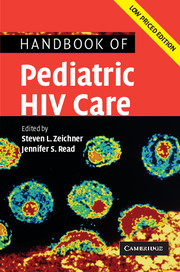Book contents
- Frontmatter
- Contents
- List of contributors
- List of abbreviations
- Foreword
- Preface
- Part I Scientific basis of pediatric HIV care
- Part II General issues in the care of pediatric HIV patients
- Part III Antiretroviral therapy
- Part IV Clinical manifestations of HIV infection in children
- Part V Infectious problems in pediatric HIV disease
- Part VI Medical, social, and legal issues
- 36 Medical issues related to the care of HIV-infected children in the home, daycare, school, and community
- 37 Contact with social service agencies
- 38 Psychosocial factors associated with childhood bereavement and grief
- 39 Legal issues for HIV-infected children
- Appendix 1 Formulary of antiretroviral agents
- Appendix 2 National Institutes of Health sponsored clinical trials for pediatric HIV disease
- Appendix 3 Selected HIV-related internet resources
- Appendix 4 Selected legal resources for HIV-infected children
- Index
- References
36 - Medical issues related to the care of HIV-infected children in the home, daycare, school, and community
Published online by Cambridge University Press: 23 December 2009
- Frontmatter
- Contents
- List of contributors
- List of abbreviations
- Foreword
- Preface
- Part I Scientific basis of pediatric HIV care
- Part II General issues in the care of pediatric HIV patients
- Part III Antiretroviral therapy
- Part IV Clinical manifestations of HIV infection in children
- Part V Infectious problems in pediatric HIV disease
- Part VI Medical, social, and legal issues
- 36 Medical issues related to the care of HIV-infected children in the home, daycare, school, and community
- 37 Contact with social service agencies
- 38 Psychosocial factors associated with childhood bereavement and grief
- 39 Legal issues for HIV-infected children
- Appendix 1 Formulary of antiretroviral agents
- Appendix 2 National Institutes of Health sponsored clinical trials for pediatric HIV disease
- Appendix 3 Selected HIV-related internet resources
- Appendix 4 Selected legal resources for HIV-infected children
- Index
- References
Summary
Introduction
Children with HIV infection spend very little time in hospital; they live, learn, grow and play in different settings in the community. Despite significant advances in the understanding of HIV infection, misconceptions continue to harm children with HIV infection. These misunderstandings have led to ostracism in situations which present no risk to others. A major challenge for those caring for children with HIV infection is to promote acceptance of HIV-infected children in the community. Healthcare providers bear an important responsibility to educate children, their caretakers, and the community at large on the risk of transmission of HIV and other infections. Recommended practices for reducing the risk for transmission should be implemented without exaggeration of risk for transmission. Every effort should be made to promote understanding and compassion, and to maintain confidentiality for children with HIV infection [1–3].
Transmission of HIV
Transmission of HIV requires a sufficient quantity of virus. The risk for transmission of HIV is directly related to exposure to contaminated body fluids [1]. HIV has been isolated from many body fluids (see Table 36.1), but HIV transmission is most commonly associated with exposure to blood or semen, which are rich in lymphocytes and monocytes [1]. There are four major modes of HIV transmission: (a) between sex partners; (b) from an HIV-infected mother to her child during pregnancy, delivery, or breastfeeding; (c) by direct inoculation of infected blood or blood-containing tissues, including transfusion, transplantation, reuse of contaminated needles, or penetrating injuries with contaminated needles; (d) splattering or spraying of mucous membranes or non-intact skin with infected blood [4].
- Type
- Chapter
- Information
- Handbook of Pediatric HIV Care , pp. 759 - 771Publisher: Cambridge University PressPrint publication year: 2006



